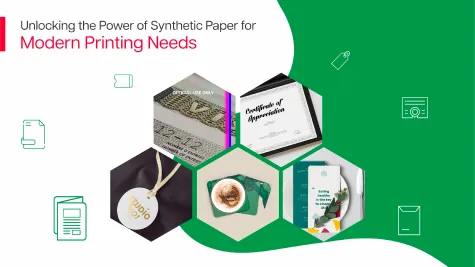Love to hear from you!
Get in touch.

Synthetic paper is a versatile substrate that has gained popularity in various printing processes, including flexography and digital Printing. Its unique properties make it suitable for a wide range of applications. It is non-tearable paper, tear–resistant, exhibits moisture and chemical resistance, and maintains excellent lay flatness.
Below, we explore the application and usage of synthetic paper in these printing methods.
Synthetic paper is a polypropylene-based innovation embraced by modern-age commercial printers, packaging converters, and security printing applications. Its exceptional tear resistance, universal printability, and durability have made it a game-changer.
This robust material is tailored for paper applications that face harsh conditions—think outdoor exposure and rough shipping. Thanks to its top-notch printing capabilities, high-quality graphics and text can be directly printed onto synthetic paper. Clearly, synthetic paper is a hot choice for manufacturers seeking sustainable and resilient solutions across various industries.
Flexography Printing:
Flexography, or flexo printing, is famous for labels, packaging, and other flexible materials. Synthetic paper is well-suited for flexo printing due to its characteristics:
a. Labels and Packaging: Synthetic paper is commonly used for label applications, including food labels, beverage labels, and industrial labels. Its durability ensures that labels maintain their integrity even in challenging environments.
b. Resistance to Moisture and Chemicals: Flexo-printed synthetic paper labels are resistant to moisture, chemicals, and oils, making them ideal for products that require long-lasting identification, such as chemical drums and cosmetic containers.
c. High-Speed Printing: Flexo presses can operate at high speeds, and synthetic paper's smooth surface and dimensional stability allow for precise and consistent Printing even in high-speed production environments.
Digital Printing:
Digital printing technologies, including inkjet and laser printing, have evolved rapidly, and synthetic paper has found various applications in this realm:
a. Short-Run Printing: Digital Printing is ideal for short-run projects, and synthetic paper's compatibility with digital presses allows for a cost-effective and quick turnaround for small print jobs.
b. Photo Printing: Synthetic paper's ability to reproduce high-resolution images with vibrant colors makes it suitable for photo albums, posters, and photographic prints.
c. On-Demand Printing: Synthetic paper is often used for on-demand applications like customised calendars, manuals, and educational materials, as it can be printed in small quantities.
d. Synthetic ID Cards: It is used for durable and membership cards that must withstand wear and tear.
In summary, synthetic paper is a versatile substrate that finds applications in flexography and digital Printing due to its durability, resistance to moisture and chemicals, and its ability to reproduce high-quality images and text. Whether you're producing marketing materials, labels, packaging, or durable documents, synthetic paper can be a valuable choice in various printing processes.
Synthetic Paper's Many Faces: Diverse Types for Diverse Needs
Cosmo Films offers a range of synthetic paper types to cater to various demands:
1. CSPS-2 (M) Paper: This is a tear-resistant, white, uncoated polypropylene-based film that can be used for conventional printing and screen-printing. It comes in reels and sheets with a 95-430 um thickness range.
2. CSPR-2 (M) TC: This type of paper is a bi-axially oriented polypropylene film with a coating on one side, making it perfect for UV offset and Flexo printing. It comes in a range of thicknesses from 65-210 um and is available on a reel. This variant is ideal for displaying important information such as maps, brochures, and doctor's sheets.
3. CSPR-2 (M) BTC: This polypropylene film is biaxially oriented and available in various thicknesses. It features a coating on both sides of the sheet and roll. It is suitable for printing methods such as Thermal Transfer Letterpress, UV Offset, and Flexo, particularly with UV and water-based inks.
4. CSPR-2 (MW) BTC: This type of paper is called Non-Tearable Paper and has a matte coating on both sides. It looks like paper but is more durable and can come in reels or sheets. This type of paper is ideal for powder toner printing with various brands such as Xerox, Konica Minolta, Ricoh, Kodak, and Canon.
5. CSPR-2 (M) HR BTC: This particular product has a coating on both sides of the sheet/roll. It is a bi-axially oriented polypropylene film available in various thicknesses, starting from 95um. It is suggested for use in painting techniques such as UV Inkjet.
6. CSPR-2 (M) FLEXI: This is a co-extruded synthetic paper that offers greater resistance to tearing compared to other options. It is available in limited thickness levels of 125, 150, 200, and 250 um and comes in reel form. This paper is ideal for thermal transfer and Flexo printing and can be used with both UV and water-based inks.
Featured Post
Love to hear from you!
Get in touch.